108 Hours, February 8, 2013
 The just-finished 4th Kandy Intensive was, in fact, our personal 9th (five in Kolkata). In many ways, this one was the most satisfying. It certainly had the greatest variety in teachers, materials, and students and a friendly, laid-back atmosphere that belied the name intensive.
The just-finished 4th Kandy Intensive was, in fact, our personal 9th (five in Kolkata). In many ways, this one was the most satisfying. It certainly had the greatest variety in teachers, materials, and students and a friendly, laid-back atmosphere that belied the name intensive.
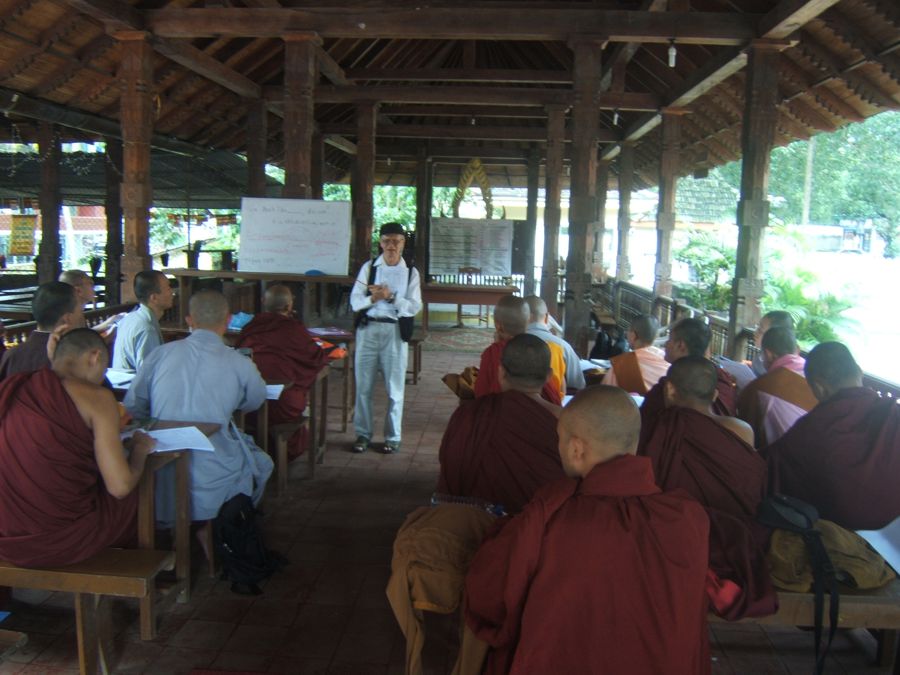 Because we offer an intensive class only in Kandy, there is keen competition among the Burmese monks studying in Colombo to join. The space at the Burmese Rest is limited, which restricts the number of monks we can include. Several students mentioned how disappointed they had been not to have gotten into previous intensives and how fortunate they felt this time. Students residing in the Kandy area, however, can be freely admitted, and we were delighted to have so many members of our Subodharama class join--Burmese, Korean, Bhutanese, and Chinese, both monks and nuns.
Because we offer an intensive class only in Kandy, there is keen competition among the Burmese monks studying in Colombo to join. The space at the Burmese Rest is limited, which restricts the number of monks we can include. Several students mentioned how disappointed they had been not to have gotten into previous intensives and how fortunate they felt this time. Students residing in the Kandy area, however, can be freely admitted, and we were delighted to have so many members of our Subodharama class join--Burmese, Korean, Bhutanese, and Chinese, both monks and nuns.
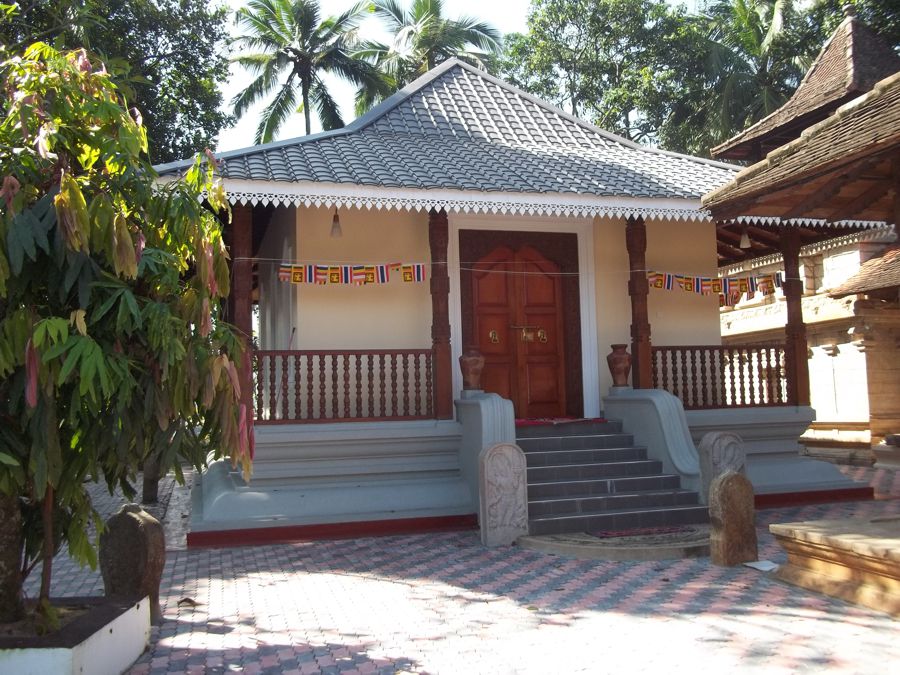 As soon as we learned that it would not be possible to have our classes at BPS as in the past, we started looking for an alternative venue. Having classes at a school during vacation would be easy, but this was not going to be vacation time. Some spaces we looked at were expensive. Ven. Villasaga, who had initially approached BPS, suggested we try the Asgiri Gedige Raja Maha Vihara, where he himself had stayed earlier. After discussing our program with the abbot, Ven. Upali, we were given the use of two large classrooms, just outside the compound of the ancient temple where the sword for the Perahera Water-Cutting Ceremony is kept, and just a few minutes from the Burmese Rest where the monks from Colombo would be staying.
As soon as we learned that it would not be possible to have our classes at BPS as in the past, we started looking for an alternative venue. Having classes at a school during vacation would be easy, but this was not going to be vacation time. Some spaces we looked at were expensive. Ven. Villasaga, who had initially approached BPS, suggested we try the Asgiri Gedige Raja Maha Vihara, where he himself had stayed earlier. After discussing our program with the abbot, Ven. Upali, we were given the use of two large classrooms, just outside the compound of the ancient temple where the sword for the Perahera Water-Cutting Ceremony is kept, and just a few minutes from the Burmese Rest where the monks from Colombo would be staying.
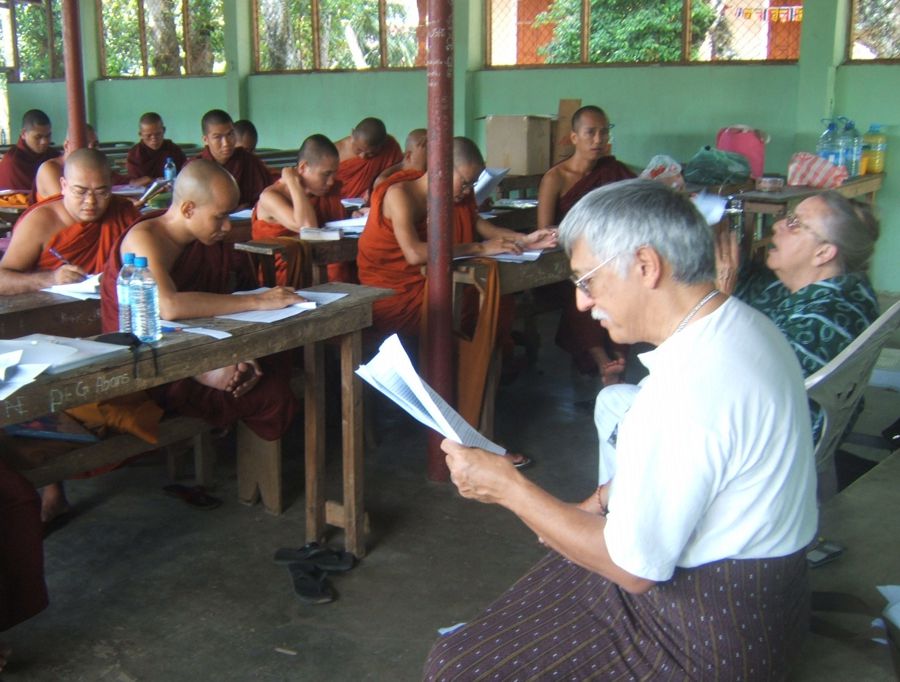
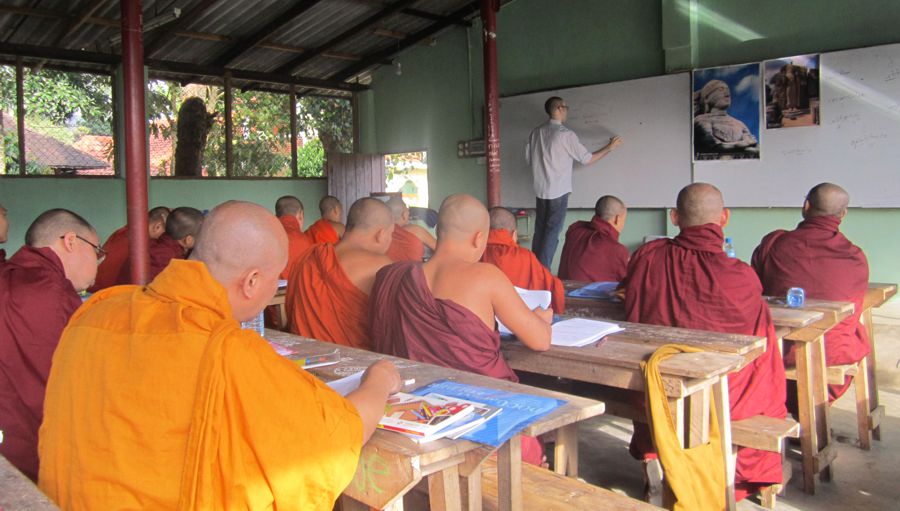 We had to adapt ourselves to a new schedule, beginning at 8 AM and finishing at 2:30 since the rooms are in daily use for tuition classes just as soon as children finish school. Likewise, we had classes Monday through Friday, but not on the weekends, when the rooms were fully booked for private lessons. Because the furniture, long benches and tables, was meant for kids, we had other adapting to do. Things tended to fall over when adults moved around, and sometimes a whole row would topple like dominoes, with considerable noise, but, happily, without damage.
We had to adapt ourselves to a new schedule, beginning at 8 AM and finishing at 2:30 since the rooms are in daily use for tuition classes just as soon as children finish school. Likewise, we had classes Monday through Friday, but not on the weekends, when the rooms were fully booked for private lessons. Because the furniture, long benches and tables, was meant for kids, we had other adapting to do. Things tended to fall over when adults moved around, and sometimes a whole row would topple like dominoes, with considerable noise, but, happily, without damage.
With a record seven teachers and shorter periods, none of us had as much time in the classroom as we would have liked, but the students certainly benefitted from a rich diversity of materials and approaches. Josh worked primarily with speaking and clear pronunciation, but he also got to know the students in an important way, through daily journals, which he faithfully read and responded to. Daniel was the first teacher besides us ever to use Merit, our ESL textbook set on a Buddhist pilgrimage. Both he and the students thoroughly enjoyed it. Daniel was able to do some informal teaching in the evening because he was also staying at the Burmese Rest.
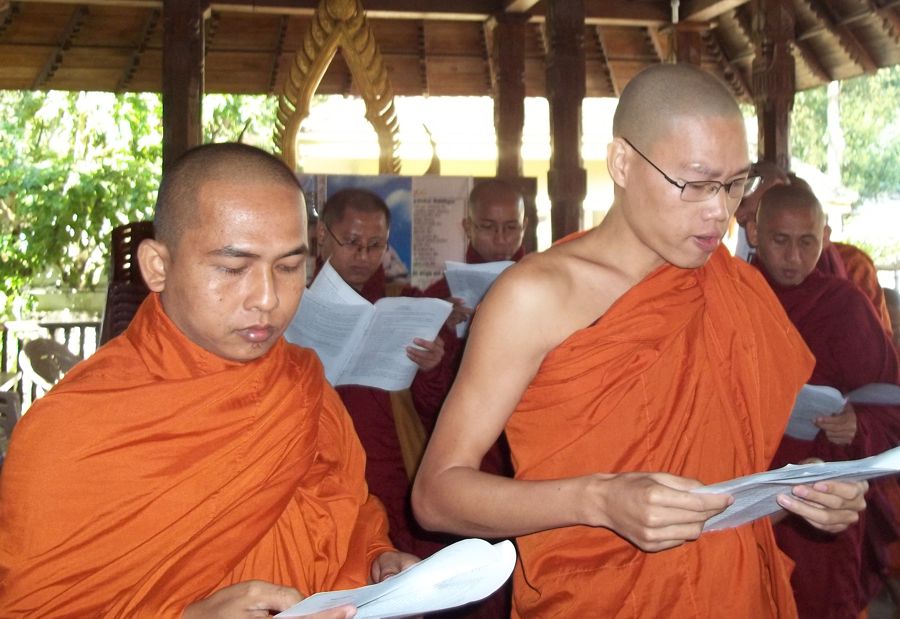
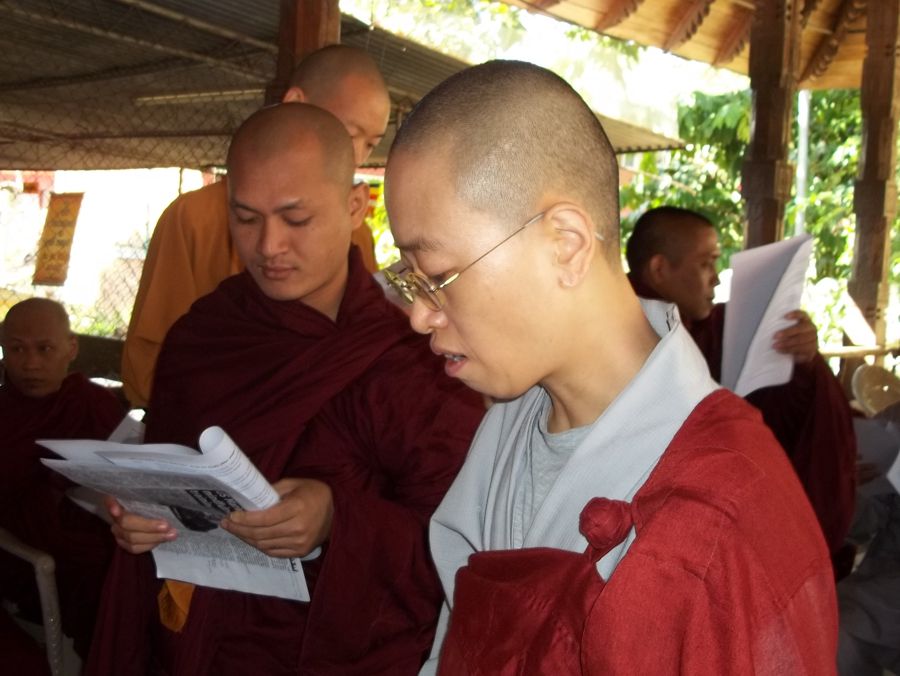 We did two different Jataka stories, "Repudiation" and "Alive or Dead, I Don't Want Her," aiming first for reading comprehension and increased vocabulary. Afterwards, each class worked with its story in script form to rehearse and present a radio play. At one point, Visakha asked if there were any last questions about the story, and a monk unhesitatingly replied, "No questions! We understand it perfectly, every word!" When it came time to present their plays, the benefits of Josh's pronunciation and intonation work were apparent to the audience! As in past courses, we gave everyone writing practice with 10 Steps, a controlled composition text, which all students seem to want to continue by e-mail from wherever they go. We also gave out our Dhamma Wordsearch Puzzle, with a worksheet on basic Buddhist vocabulary, and Wise Reflections, a compilation of verses, invocations, and meditations, which we tried to fit into our class sessions.
We did two different Jataka stories, "Repudiation" and "Alive or Dead, I Don't Want Her," aiming first for reading comprehension and increased vocabulary. Afterwards, each class worked with its story in script form to rehearse and present a radio play. At one point, Visakha asked if there were any last questions about the story, and a monk unhesitatingly replied, "No questions! We understand it perfectly, every word!" When it came time to present their plays, the benefits of Josh's pronunciation and intonation work were apparent to the audience! As in past courses, we gave everyone writing practice with 10 Steps, a controlled composition text, which all students seem to want to continue by e-mail from wherever they go. We also gave out our Dhamma Wordsearch Puzzle, with a worksheet on basic Buddhist vocabulary, and Wise Reflections, a compilation of verses, invocations, and meditations, which we tried to fit into our class sessions.
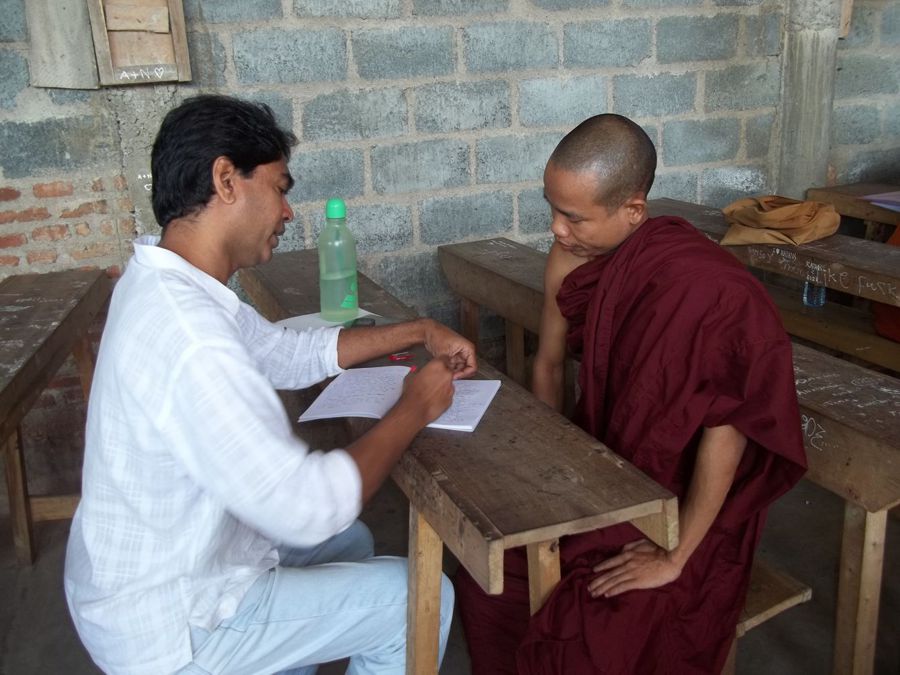
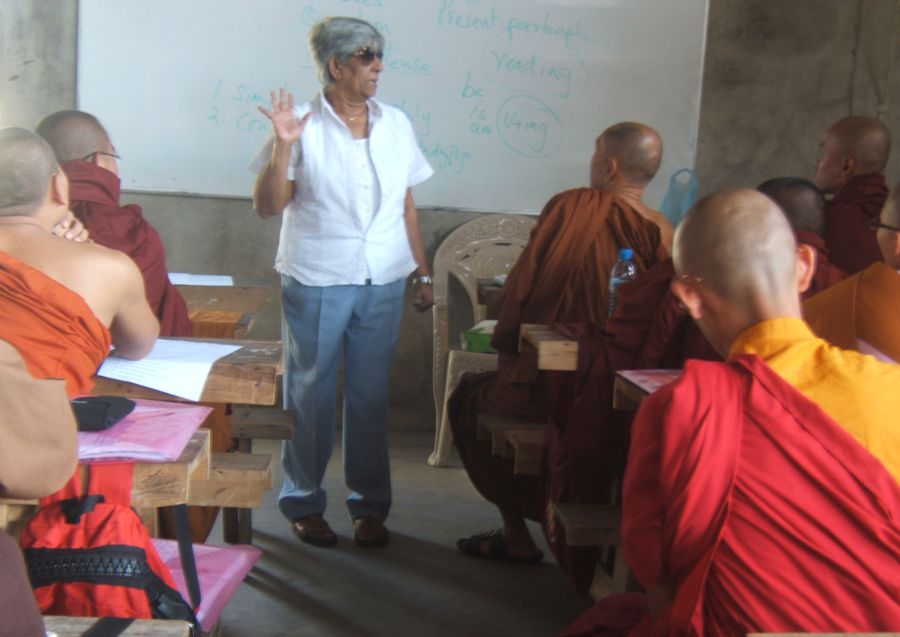 Lal came from Colombo to teach academic writing--essential because all the students are in university programs in Kelaniya, Colombo, or Peradeniya. Lalitha focused on grammar and communicative activities. Ven. Upatissa came up from Ja Ela twice to do workshops on counseling. He introduced some of the important theories in the field and gave the students a chance to practice role playing. He also emphasized the need for monastics to develop empathetic listening techniques and to preserve confidentiality. Good therapists are few and far between here in Sri Lanka, but, in Burma, where civil war, military rule, poverty, and social turmoil have caused great strains and counselors are desperately needed, the service is virtually unknown.
Lal came from Colombo to teach academic writing--essential because all the students are in university programs in Kelaniya, Colombo, or Peradeniya. Lalitha focused on grammar and communicative activities. Ven. Upatissa came up from Ja Ela twice to do workshops on counseling. He introduced some of the important theories in the field and gave the students a chance to practice role playing. He also emphasized the need for monastics to develop empathetic listening techniques and to preserve confidentiality. Good therapists are few and far between here in Sri Lanka, but, in Burma, where civil war, military rule, poverty, and social turmoil have caused great strains and counselors are desperately needed, the service is virtually unknown. 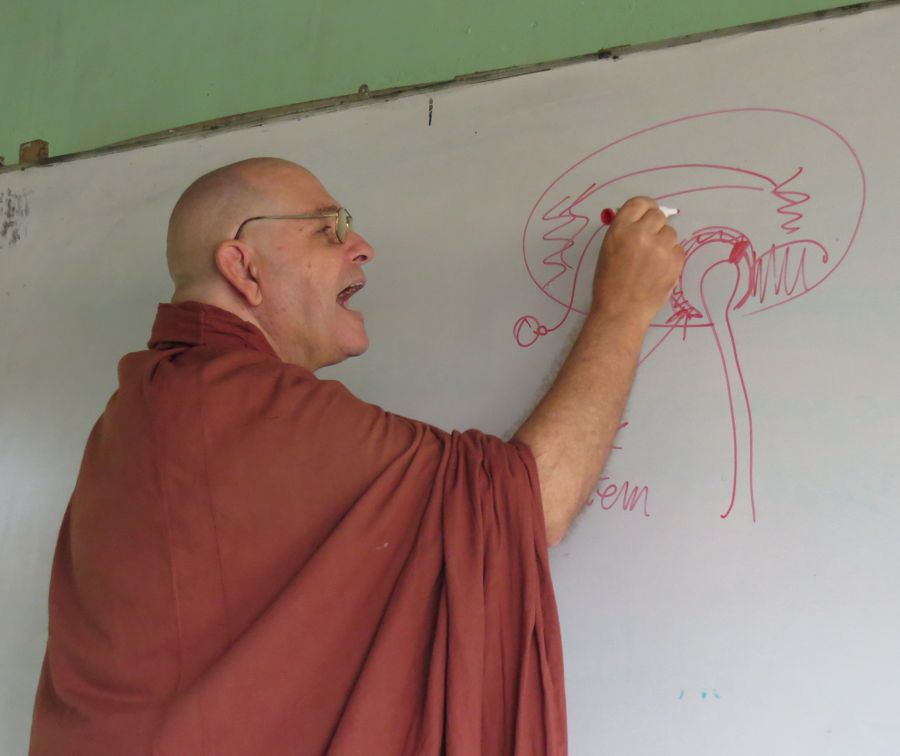 Ven. Upatissa encouraged the students to get more training, and several expressed an enthusiastic determination to do just that.
Ven. Upatissa encouraged the students to get more training, and several expressed an enthusiastic determination to do just that.
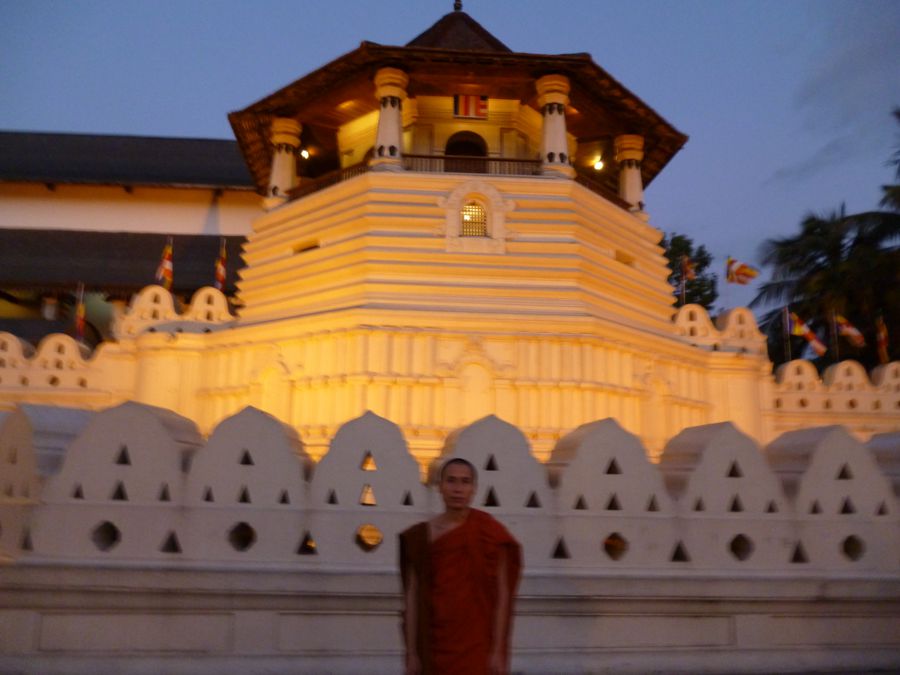 As it turned out, having the weekends off was a real blessing. The monks and nuns had ample time for the huge amounts of writing we asked them to do and for out-of-class assignments in and around Kandy. At the opening ceremony, we handed out a challenging "discovery worksheet" about the Temple of the Tooth, the Devales, and environs to be done in groups in their free time. On Sundays, we scheduled some excursions and invited friends to join so that the students would have a chance to talk with others besides their regular teachers.
As it turned out, having the weekends off was a real blessing. The monks and nuns had ample time for the huge amounts of writing we asked them to do and for out-of-class assignments in and around Kandy. At the opening ceremony, we handed out a challenging "discovery worksheet" about the Temple of the Tooth, the Devales, and environs to be done in groups in their free time. On Sundays, we scheduled some excursions and invited friends to join so that the students would have a chance to talk with others besides their regular teachers. 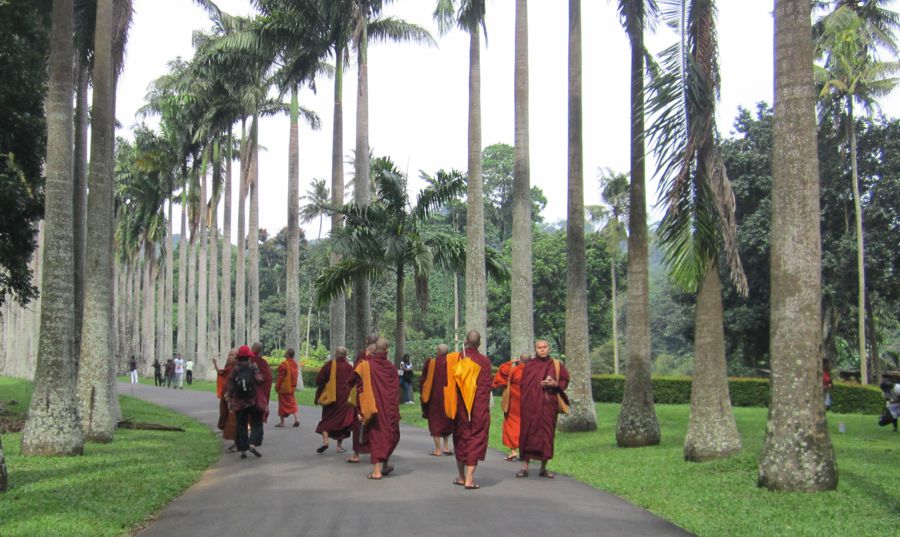 The visit to the Royal Botanical Gardens in Peradeniya was a treat, with splendid weather, much enjoyed by all. It also provided some terrific photo opportunities.
The visit to the Royal Botanical Gardens in Peradeniya was a treat, with splendid weather, much enjoyed by all. It also provided some terrific photo opportunities. 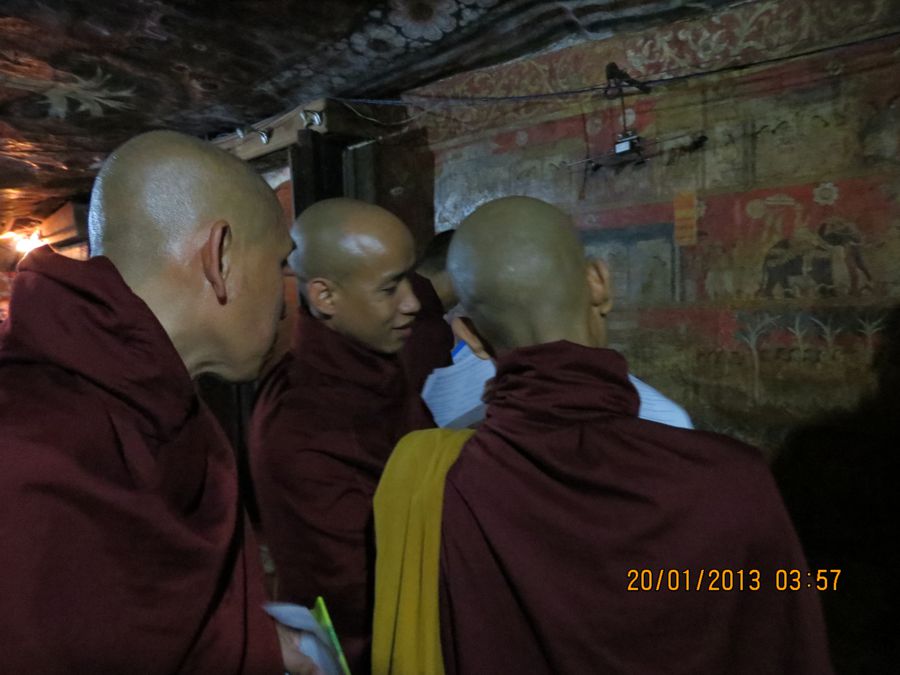 Next was a visit to three temples around Kandy--the painted cave temple of Degaldoruwa, the South Indian-style rock temple of Gadaladeniya, and the elegant Sri Lankan vihara of Lankatilika where there is a rock inscription in both Sinhalese and Tamil. That bus trip ended up in Anniwatte, for some refreshing drinks and a tour of our house and library for those Burmese who'd never been here. Before the group left, all fifty monks and nuns arranged themselves in front of the altar to chant blessings and share merit!
Next was a visit to three temples around Kandy--the painted cave temple of Degaldoruwa, the South Indian-style rock temple of Gadaladeniya, and the elegant Sri Lankan vihara of Lankatilika where there is a rock inscription in both Sinhalese and Tamil. That bus trip ended up in Anniwatte, for some refreshing drinks and a tour of our house and library for those Burmese who'd never been here. Before the group left, all fifty monks and nuns arranged themselves in front of the altar to chant blessings and share merit! 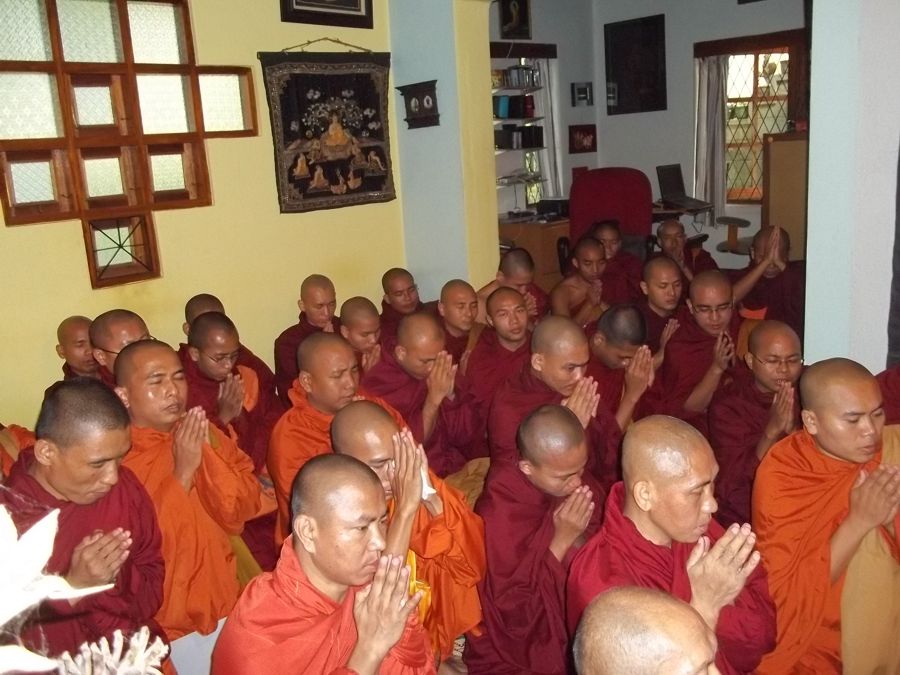 The last excursion was to the new International Buddhist Museum behind the Temple of the Tooth. Josh had visited the museum twice to prepare a detailed questionnaire which guided the students from room to room, encouraging them to ask questions of fellow students, to examine the exhibits closely, and to talk about their own traditions.
The last excursion was to the new International Buddhist Museum behind the Temple of the Tooth. Josh had visited the museum twice to prepare a detailed questionnaire which guided the students from room to room, encouraging them to ask questions of fellow students, to examine the exhibits closely, and to talk about their own traditions.
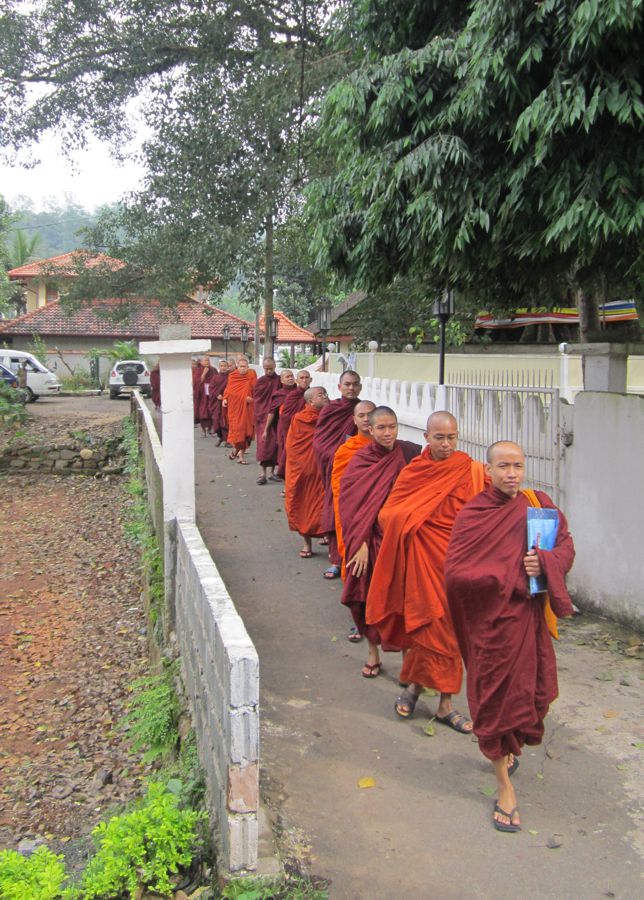 As we'd done previously, we requested the use of the American Corner for two sessions to view a movie for discussion. After getting approval, choosing "To Kill a Mockingbird," and preparing worksheets, we finalized our schedule. Just after our opening ceremony, in the midst of torrential rain, lightning, and thunder, Visakha's cell phone rang. Although she was standing in several inches of water, she stopped under a gnarled plumeria tree to answer it. It was from the US Embassy in Colombo. Some Sinhalese staff members had expressed concern at our showing a movie to fully-ordained members of the Sangha. They feared that Sri Lankan monks might complain about such "entertainment." Of course, this was an English study program for foreign monks and nuns, and we'd used that same film successfully in the past, but we immediately cancelled the program. There was no point in attracting criticism.
As we'd done previously, we requested the use of the American Corner for two sessions to view a movie for discussion. After getting approval, choosing "To Kill a Mockingbird," and preparing worksheets, we finalized our schedule. Just after our opening ceremony, in the midst of torrential rain, lightning, and thunder, Visakha's cell phone rang. Although she was standing in several inches of water, she stopped under a gnarled plumeria tree to answer it. It was from the US Embassy in Colombo. Some Sinhalese staff members had expressed concern at our showing a movie to fully-ordained members of the Sangha. They feared that Sri Lankan monks might complain about such "entertainment." Of course, this was an English study program for foreign monks and nuns, and we'd used that same film successfully in the past, but we immediately cancelled the program. There was no point in attracting criticism.
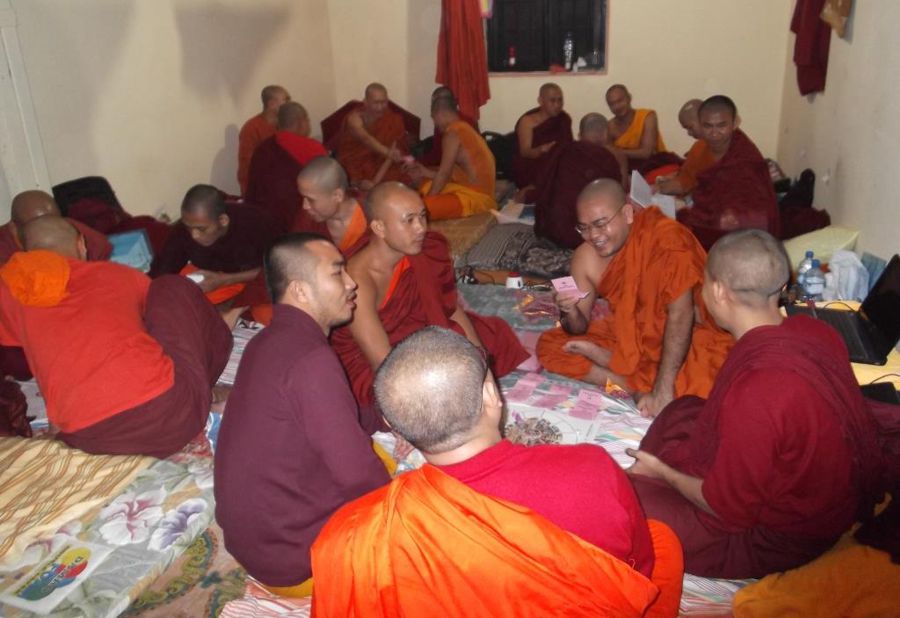 |
|
| Click this photo to see more photos of the students at the Burmese Rest. |
|
|
|
It's important to remember that our students, as well as improving their English abilities for their own university studies, are learning teaching methods. Many of the Burmese monks and nuns will be going back to their towns and villages to set up schools and, using the methods they were exposed to in these classes, they will be able to influence the next generation of students. Josh introduced them to much about their own languages they hadn't known before. He explained how it interfered with their spoken English and gave them techniques to overcome the problems. We had to feel flattered when students asked for Buddhist Knowledge Quest, Buddhist Concentration, and Buddhist Go Fish. One old student aims to establish a monastic education program in Rangoon when he has finished his degree here, and he is eager to use Merit, which we MUST finish as soon as we can.
 |
|
| Click this photo to view a slideshow of all the lunches, including a recording of the chanting of anumodana. |
|
|
|
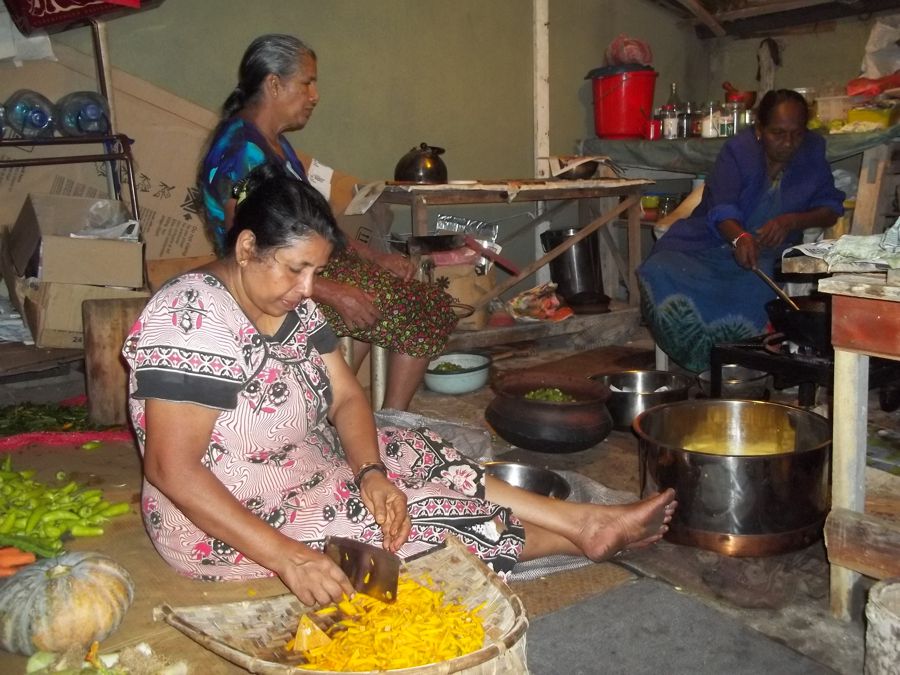 Many friends and supporters want to take part in the intensive, but few are able to come and teach. Offering lunch to all the student monks and nuns is one way for them to join in the merit, and many generous donors responded. Every day, our cooks prepared delicious and wholesome vegetarian curries in the kitchen annex outside our bedroom. Lily, Margaret, and Soma cut vegetables in the evening. After sleeping a few hours in the storeroom, they began at 3 AM cooking rice and the curries. About 7:30, Charles, Manel, and Surangi came to help wrap the packets in banana leaf, lunch wrap, and paper. At 10 o'clock, Ashoka picked up the two big boxes holding the sixty packets, along with fried peanuts, bitter gourd chips, papadams, dessert (cookies, caramels, cake, or yoghurt), and fruit (alternately bananas and oranges) and delivered it all to the temple. He also delivered four or five 5-liter bottes of water each day and one or two bottles of juice for the students. On two occasions, we offered catumadhu that we had made. A bulletin board at the front of the room announced the donor for that day. Teachers and other lay visitors distributed packets to all the monks and nuns. Then the monks in charge read the donors' names and asked the monks to chant for the donors' and their relatives' well-being, health, prosperity, and happiness.
Many friends and supporters want to take part in the intensive, but few are able to come and teach. Offering lunch to all the student monks and nuns is one way for them to join in the merit, and many generous donors responded. Every day, our cooks prepared delicious and wholesome vegetarian curries in the kitchen annex outside our bedroom. Lily, Margaret, and Soma cut vegetables in the evening. After sleeping a few hours in the storeroom, they began at 3 AM cooking rice and the curries. About 7:30, Charles, Manel, and Surangi came to help wrap the packets in banana leaf, lunch wrap, and paper. At 10 o'clock, Ashoka picked up the two big boxes holding the sixty packets, along with fried peanuts, bitter gourd chips, papadams, dessert (cookies, caramels, cake, or yoghurt), and fruit (alternately bananas and oranges) and delivered it all to the temple. He also delivered four or five 5-liter bottes of water each day and one or two bottles of juice for the students. On two occasions, we offered catumadhu that we had made. A bulletin board at the front of the room announced the donor for that day. Teachers and other lay visitors distributed packets to all the monks and nuns. Then the monks in charge read the donors' names and asked the monks to chant for the donors' and their relatives' well-being, health, prosperity, and happiness.

 Generous gifts came from far and wide. The first to contribute was Ven. Beobgwa, who gave us her gift before leaving Sri Lanka early last year for studies in Rangoon. Deena and Matt had planned to join in teaching in the course and had even bought their plane tickets, but illness prevented their coming. They promised to come next year. Lal (joined by his wife, sister-in-law, and friend), Josh, and Amal were able to offer lunch with their own hands. Dushy was not able to come up from Colombo, but offered lunch in memory of her late mother and another dear friend. Visakha's cousins Cameron and Joene, Ken's friend from college Willem, and correspondents Deborah and Gerald made donations from the United States. When we visited Bangkok in October, Julie and Moon made a contribution. Rajah, who has visited us several times, sent a donation from Germany. Gabriel from Brazil and Shanty from Indonesia sent contributions. Some of the students--Ven. Piyabanini, Ven. Dohyoung, and the Myanmar students from Peradeniya--also contributed. Several old friends wrote that, although they wanted to support the program as in the past, they regretted that the new year was looking bleak, and they just couldn't spare any money. We assured them that they were still part of it all because of their good wishes. Each day, we shared merit with all well-wishers and, indeed, with all beings. Sadhu! Sadhu!! Sadhu!!!
Generous gifts came from far and wide. The first to contribute was Ven. Beobgwa, who gave us her gift before leaving Sri Lanka early last year for studies in Rangoon. Deena and Matt had planned to join in teaching in the course and had even bought their plane tickets, but illness prevented their coming. They promised to come next year. Lal (joined by his wife, sister-in-law, and friend), Josh, and Amal were able to offer lunch with their own hands. Dushy was not able to come up from Colombo, but offered lunch in memory of her late mother and another dear friend. Visakha's cousins Cameron and Joene, Ken's friend from college Willem, and correspondents Deborah and Gerald made donations from the United States. When we visited Bangkok in October, Julie and Moon made a contribution. Rajah, who has visited us several times, sent a donation from Germany. Gabriel from Brazil and Shanty from Indonesia sent contributions. Some of the students--Ven. Piyabanini, Ven. Dohyoung, and the Myanmar students from Peradeniya--also contributed. Several old friends wrote that, although they wanted to support the program as in the past, they regretted that the new year was looking bleak, and they just couldn't spare any money. We assured them that they were still part of it all because of their good wishes. Each day, we shared merit with all well-wishers and, indeed, with all beings. Sadhu! Sadhu!! Sadhu!!!
 Food prices skyrocketed alarmingly just before the course started, but Lily went several times at 5 AM to the market in Katsugastota to get the pick of available vegetables. For some weeks prior to the course, we had stockpiled oil, chutney, and Danish cookies at bargain prices, and, of course, the banana leaves came from the garden beside our house.
Food prices skyrocketed alarmingly just before the course started, but Lily went several times at 5 AM to the market in Katsugastota to get the pick of available vegetables. For some weeks prior to the course, we had stockpiled oil, chutney, and Danish cookies at bargain prices, and, of course, the banana leaves came from the garden beside our house.
 Nothing was wasted. If there were extra lunch packets, they were shared with poor people in the neighborhood. Once, Ashoka gave several packets to a road crew laboring nearby. One day, Josh gave a packet to an old man resting in the temple compound, who blessed him and said that he hadn't eaten that day. Each day we placed a plastic bag on one of the tables and collected leftover rice and curry from the packets. Ashoka distributed this to stray dogs on his way back home.
Nothing was wasted. If there were extra lunch packets, they were shared with poor people in the neighborhood. Once, Ashoka gave several packets to a road crew laboring nearby. One day, Josh gave a packet to an old man resting in the temple compound, who blessed him and said that he hadn't eaten that day. Each day we placed a plastic bag on one of the tables and collected leftover rice and curry from the packets. Ashoka distributed this to stray dogs on his way back home.
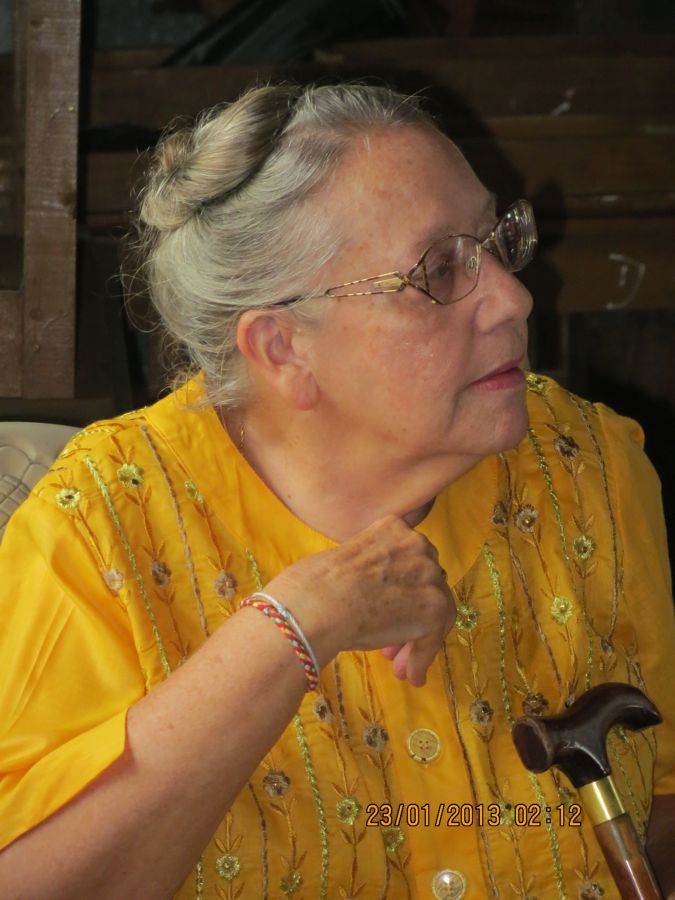
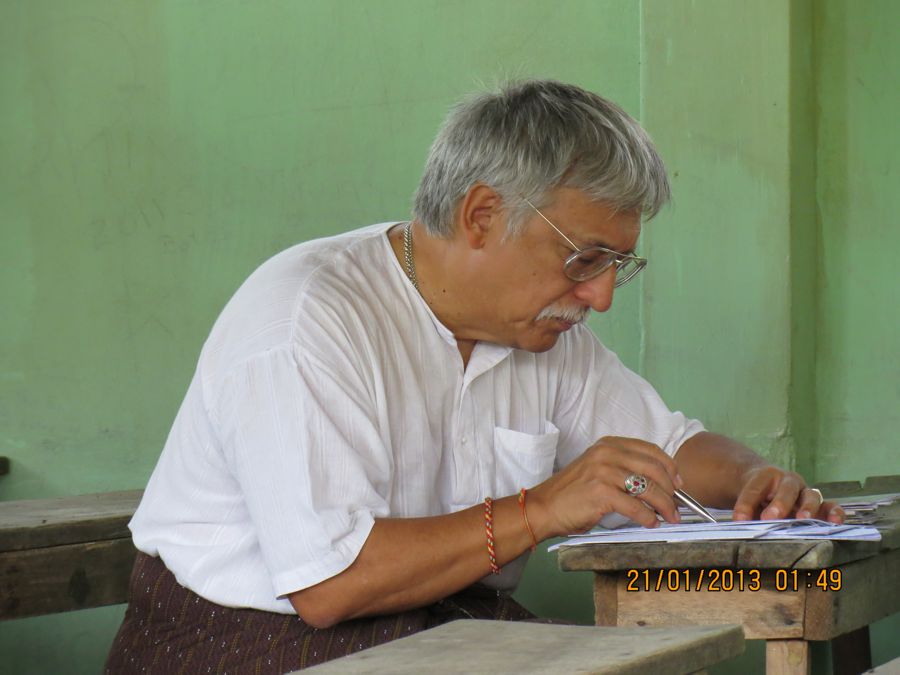 We know that we're the luckiest people in the world. We get to work with dedicated and inspiring teachers, doing what we love best--teaching the most eager and agreeable students and learning Dhamma from them. Again and again, in the closing ceremony, there was mention of the next Intensive. If we're still alive and able, we hope it happens. The friendships formed, the students' progress in communication, the enjoyment from using good materials, the wholesome Dhamma discussions, and the cheerful smiles--all these satisfactions--are rewards aplenty.
We know that we're the luckiest people in the world. We get to work with dedicated and inspiring teachers, doing what we love best--teaching the most eager and agreeable students and learning Dhamma from them. Again and again, in the closing ceremony, there was mention of the next Intensive. If we're still alive and able, we hope it happens. The friendships formed, the students' progress in communication, the enjoyment from using good materials, the wholesome Dhamma discussions, and the cheerful smiles--all these satisfactions--are rewards aplenty.
 The just-finished 4th Kandy Intensive was, in fact, our personal 9th (five in Kolkata). In many ways, this one was the most satisfying. It certainly had the greatest variety in teachers, materials, and students and a friendly, laid-back atmosphere that belied the name intensive.
The just-finished 4th Kandy Intensive was, in fact, our personal 9th (five in Kolkata). In many ways, this one was the most satisfying. It certainly had the greatest variety in teachers, materials, and students and a friendly, laid-back atmosphere that belied the name intensive.
 As soon as we learned that it would not be possible to have our classes at BPS as in the past, we started looking for an alternative venue. Having classes at a school during vacation would be easy, but this was not going to be vacation time. Some spaces we looked at were expensive. Ven. Villasaga, who had initially approached BPS, suggested we try the Asgiri Gedige Raja Maha Vihara, where he himself had stayed earlier. After discussing our program with the abbot, Ven. Upali, we were given the use of two large classrooms, just outside the compound of the ancient temple where the sword for the Perahera Water-Cutting Ceremony is kept, and just a few minutes from the Burmese Rest where the monks from Colombo would be staying.
As soon as we learned that it would not be possible to have our classes at BPS as in the past, we started looking for an alternative venue. Having classes at a school during vacation would be easy, but this was not going to be vacation time. Some spaces we looked at were expensive. Ven. Villasaga, who had initially approached BPS, suggested we try the Asgiri Gedige Raja Maha Vihara, where he himself had stayed earlier. After discussing our program with the abbot, Ven. Upali, we were given the use of two large classrooms, just outside the compound of the ancient temple where the sword for the Perahera Water-Cutting Ceremony is kept, and just a few minutes from the Burmese Rest where the monks from Colombo would be staying. 
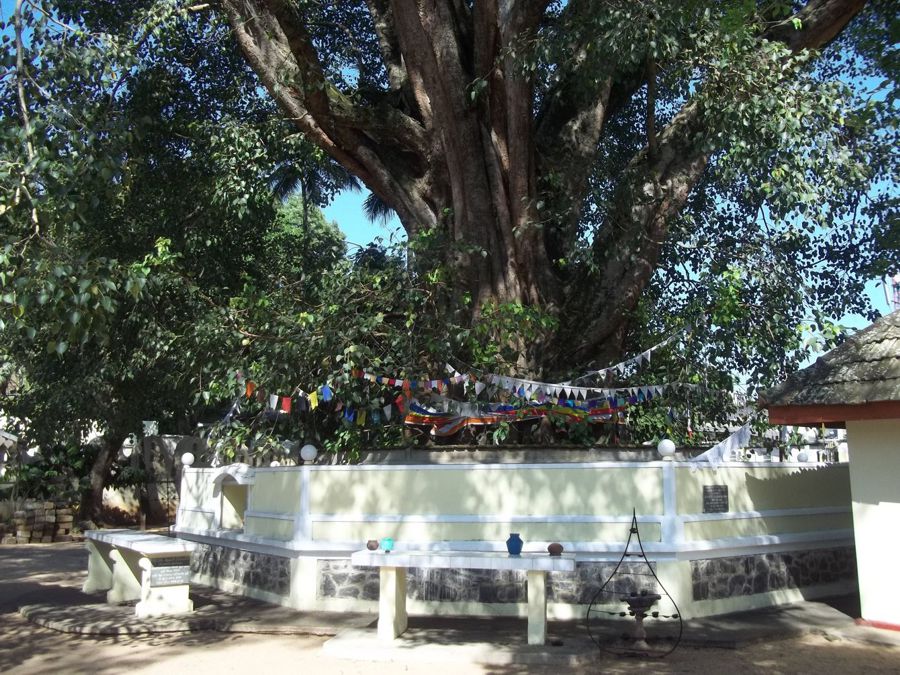
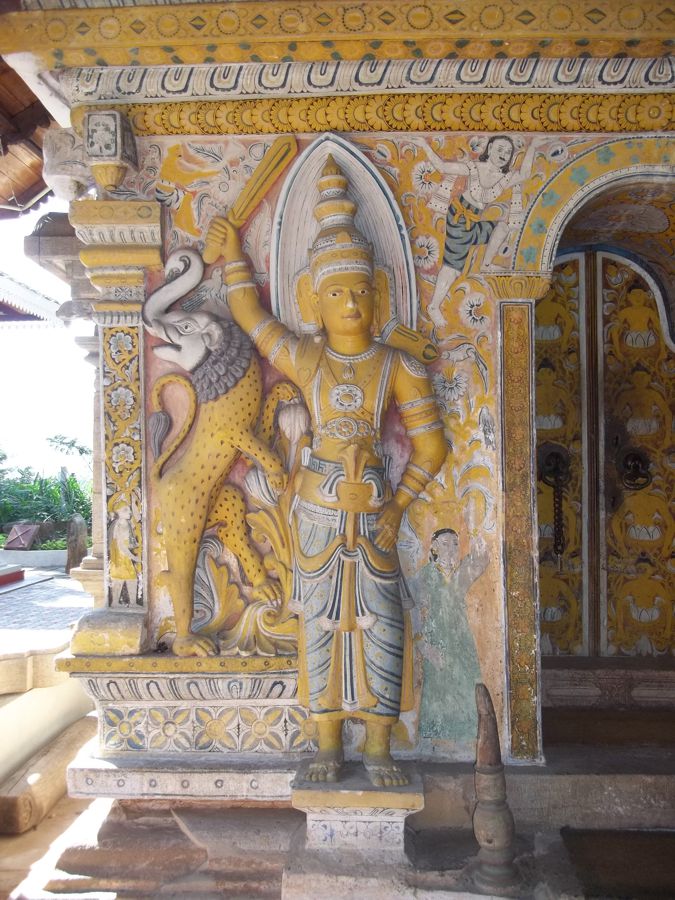
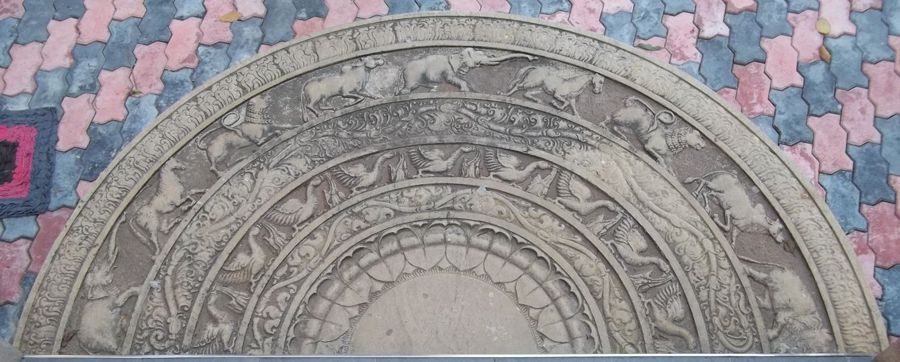









 Next was a visit to three temples around Kandy--the painted cave temple of
Next was a visit to three temples around Kandy--the painted cave temple of  The last excursion was to the new International Buddhist Museum behind the Temple of the Tooth. Josh had visited the museum twice to prepare a detailed questionnaire which guided the students from room to room, encouraging them to ask questions of fellow students, to examine the exhibits closely, and to talk about their own traditions.
The last excursion was to the new International Buddhist Museum behind the Temple of the Tooth. Josh had visited the museum twice to prepare a detailed questionnaire which guided the students from room to room, encouraging them to ask questions of fellow students, to examine the exhibits closely, and to talk about their own traditions. As we'd done previously, we requested the use of the American Corner for two sessions to view a movie for discussion. After getting approval, choosing "To Kill a Mockingbird," and preparing worksheets, we finalized our schedule. Just after our opening ceremony, in the midst of torrential rain, lightning, and thunder, Visakha's cell phone rang. Although she was standing in several inches of water, she stopped under a gnarled plumeria tree to answer it. It was from the US Embassy in Colombo. Some Sinhalese staff members had expressed concern at our showing a movie to fully-ordained members of the Sangha. They feared that Sri Lankan monks might complain about such "entertainment." Of course, this was an English study program for foreign monks and nuns, and we'd used that same film successfully in the past, but we immediately cancelled the program. There was no point in attracting criticism.
As we'd done previously, we requested the use of the American Corner for two sessions to view a movie for discussion. After getting approval, choosing "To Kill a Mockingbird," and preparing worksheets, we finalized our schedule. Just after our opening ceremony, in the midst of torrential rain, lightning, and thunder, Visakha's cell phone rang. Although she was standing in several inches of water, she stopped under a gnarled plumeria tree to answer it. It was from the US Embassy in Colombo. Some Sinhalese staff members had expressed concern at our showing a movie to fully-ordained members of the Sangha. They feared that Sri Lankan monks might complain about such "entertainment." Of course, this was an English study program for foreign monks and nuns, and we'd used that same film successfully in the past, but we immediately cancelled the program. There was no point in attracting criticism. 

 Many friends and supporters want to take part in the intensive, but few are able to come and teach. Offering lunch to all the student monks and nuns is one way for them to join in the merit, and many generous donors responded. Every day, our cooks prepared delicious and wholesome vegetarian curries in the kitchen annex outside our bedroom. Lily, Margaret, and Soma cut vegetables in the evening. After sleeping a few hours in the storeroom, they began at 3 AM cooking rice and the curries. About 7:30, Charles, Manel, and Surangi came to help wrap the packets in banana leaf, lunch wrap, and paper. At 10 o'clock, Ashoka picked up the two big boxes holding the sixty packets, along with fried peanuts, bitter gourd chips, papadams, dessert (cookies, caramels, cake, or yoghurt), and fruit (alternately bananas and oranges) and delivered it all to the temple. He also delivered four or five 5-liter bottes of water each day and one or two bottles of juice for the students. On two occasions, we offered catumadhu that we had made. A bulletin board at the front of the room announced the donor for that day. Teachers and other lay visitors distributed packets to all the monks and nuns. Then the monks in charge read the donors' names and asked the monks to chant for the donors' and their relatives' well-being, health, prosperity, and happiness.
Many friends and supporters want to take part in the intensive, but few are able to come and teach. Offering lunch to all the student monks and nuns is one way for them to join in the merit, and many generous donors responded. Every day, our cooks prepared delicious and wholesome vegetarian curries in the kitchen annex outside our bedroom. Lily, Margaret, and Soma cut vegetables in the evening. After sleeping a few hours in the storeroom, they began at 3 AM cooking rice and the curries. About 7:30, Charles, Manel, and Surangi came to help wrap the packets in banana leaf, lunch wrap, and paper. At 10 o'clock, Ashoka picked up the two big boxes holding the sixty packets, along with fried peanuts, bitter gourd chips, papadams, dessert (cookies, caramels, cake, or yoghurt), and fruit (alternately bananas and oranges) and delivered it all to the temple. He also delivered four or five 5-liter bottes of water each day and one or two bottles of juice for the students. On two occasions, we offered catumadhu that we had made. A bulletin board at the front of the room announced the donor for that day. Teachers and other lay visitors distributed packets to all the monks and nuns. Then the monks in charge read the donors' names and asked the monks to chant for the donors' and their relatives' well-being, health, prosperity, and happiness.
 Generous gifts came from far and wide. The first to contribute was Ven. Beobgwa, who gave us her gift before leaving Sri Lanka early last year for studies in Rangoon. Deena and Matt had planned to join in teaching in the course and had even bought their plane tickets, but illness prevented their coming. They promised to come next year. Lal (joined by his wife, sister-in-law, and friend), Josh, and Amal were able to offer lunch with their own hands. Dushy was not able to come up from Colombo, but offered lunch in memory of her late mother and another dear friend. Visakha's cousins Cameron and Joene, Ken's friend from college Willem, and correspondents Deborah and Gerald made donations from the United States. When we visited Bangkok in October, Julie and Moon made a contribution. Rajah, who has visited us several times, sent a donation from Germany. Gabriel from Brazil and Shanty from Indonesia sent contributions. Some of the students--Ven. Piyabanini, Ven. Dohyoung, and the Myanmar students from Peradeniya--also contributed. Several old friends wrote that, although they wanted to support the program as in the past, they regretted that the new year was looking bleak, and they just couldn't spare any money. We assured them that they were still part of it all because of their good wishes. Each day, we shared merit with all well-wishers and, indeed, with all beings. Sadhu! Sadhu!! Sadhu!!!
Generous gifts came from far and wide. The first to contribute was Ven. Beobgwa, who gave us her gift before leaving Sri Lanka early last year for studies in Rangoon. Deena and Matt had planned to join in teaching in the course and had even bought their plane tickets, but illness prevented their coming. They promised to come next year. Lal (joined by his wife, sister-in-law, and friend), Josh, and Amal were able to offer lunch with their own hands. Dushy was not able to come up from Colombo, but offered lunch in memory of her late mother and another dear friend. Visakha's cousins Cameron and Joene, Ken's friend from college Willem, and correspondents Deborah and Gerald made donations from the United States. When we visited Bangkok in October, Julie and Moon made a contribution. Rajah, who has visited us several times, sent a donation from Germany. Gabriel from Brazil and Shanty from Indonesia sent contributions. Some of the students--Ven. Piyabanini, Ven. Dohyoung, and the Myanmar students from Peradeniya--also contributed. Several old friends wrote that, although they wanted to support the program as in the past, they regretted that the new year was looking bleak, and they just couldn't spare any money. We assured them that they were still part of it all because of their good wishes. Each day, we shared merit with all well-wishers and, indeed, with all beings. Sadhu! Sadhu!! Sadhu!!! Food prices skyrocketed alarmingly just before the course started, but Lily went several times at 5 AM to the market in Katsugastota to get the pick of available vegetables. For some weeks prior to the course, we had stockpiled oil, chutney, and Danish cookies at bargain prices, and, of course, the banana leaves came from the garden beside our house.
Food prices skyrocketed alarmingly just before the course started, but Lily went several times at 5 AM to the market in Katsugastota to get the pick of available vegetables. For some weeks prior to the course, we had stockpiled oil, chutney, and Danish cookies at bargain prices, and, of course, the banana leaves came from the garden beside our house.  Nothing was wasted. If there were extra lunch packets, they were shared with poor people in the neighborhood. Once, Ashoka gave several packets to a road crew laboring nearby. One day, Josh gave a packet to an old man resting in the temple compound, who blessed him and said that he hadn't eaten that day. Each day we placed a plastic bag on one of the tables and collected leftover rice and curry from the packets. Ashoka distributed this to stray dogs on his way back home.
Nothing was wasted. If there were extra lunch packets, they were shared with poor people in the neighborhood. Once, Ashoka gave several packets to a road crew laboring nearby. One day, Josh gave a packet to an old man resting in the temple compound, who blessed him and said that he hadn't eaten that day. Each day we placed a plastic bag on one of the tables and collected leftover rice and curry from the packets. Ashoka distributed this to stray dogs on his way back home. 
 We know that we're the luckiest people in the world. We get to work with dedicated and inspiring teachers, doing what we love best--teaching the most eager and agreeable students and learning Dhamma from them. Again and again, in the
We know that we're the luckiest people in the world. We get to work with dedicated and inspiring teachers, doing what we love best--teaching the most eager and agreeable students and learning Dhamma from them. Again and again, in the 

